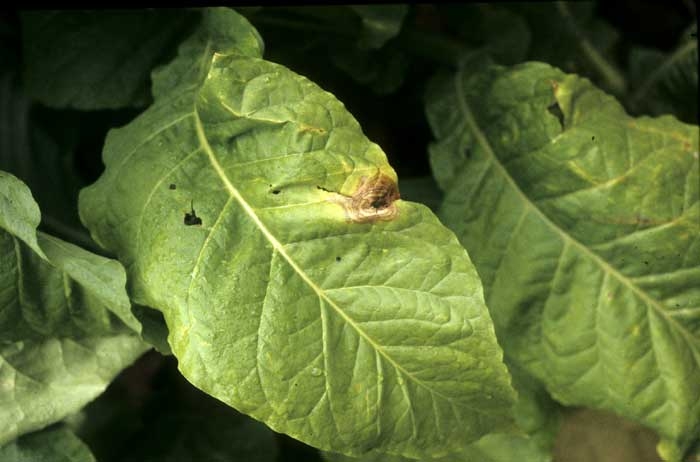
Leaf spots
In this section on leaf spots we will consider various symptoms localised on the lamina:
- small, often necrotic spots at the end of their development;
- brown to black spots (figure 1);
- yellow, beige, grey spots, (figure 2);
- spot areas with powdery, velvety surface (figure 3);
- spot areas varying from beige to dark brown (figure 4).
 |
 |
 |
 |
| Figure 1 | Figure 2 |
Figure 3 | Figure 4 |
In the presence of these symptoms there are many possible causes:
- most often parasitic, caused by different pathogens such as:
- bacteria, Pectobacterium spp., Pseudomonas aeruginosa, Pseudomonas cichorii, Pseudomonas melleum, Pseudomonas syringae pv. tabaci, Pseudomonas syringae pv. angulata;
- many fungi and the like such as Alternaria alternata, Boeremia exigua var. exigua (formerly Ascochyta nicotianae), Botrytis cinerea, Cercospora nicotianae, Corynespora cassiicola, Colletotrichum tabacum, Curvularia verriculosa, Golovinomyces cichoracearum var. cichoracearum (formerly Erysiphe cichoracearum), Peronospora hyoscyami f.sp. tabacina, Phyllosticta nicotianae, Phytophthora nicotianae, Puccinia substriata, Thanatephorus cucumeris, Uredo nicotianae;
- viruses, including tomato spotted wilt virus (TSWV) virus, cucumber mosaic virus (CMV), potato virus Y (PVY), "ring spot" virus (TRSV), and other viruses (VTE TVMV, TSV, TNV ...);
- a nematode, Aphelanchoides ritzemabosi;
- but also non-parasitic
- genetic abnormalities;
- browning of midribs;
- nutritional disorders;
- the "wet spots";
- various chemical injuries.
- linked to the presence of pests
- spider mites ;
- leaf hoppers ;
- thrips;
- and the development of sooty mould (see also the link of Pests and Sooty mould)
Diagnosis based on leaf spots is often quite difficult. Indeed, as we have previously suggested many pathogens are likely to cause spots on leaves which are quite similar to those caused by various non-parasitic diseases. Risk of confusion is important. To facilitate disease identification, we recommend the following approach:
- Observe the spots on several leaves of many plants in order to assess their development over time (size, colour, presence of a halo, distribution on the plant and on the leaves ...) ;
- Observe carefully the spots and their vicinity. Do it as well on the upper as the lower lamina side, in order to detect the possible presence of tiny fruiting bodies or other items to support the diagnosis. In this case a magnifying glass is useful;
- See successively all the sub-sections concerning leaf spots





